Inseego NVWE725 Dual-Band CDMA / EVDO Modem Card User Manual book
Novatel Wireless Inc Dual-Band CDMA / EVDO Modem Card book
Inseego >
Contents
Users Manual 6
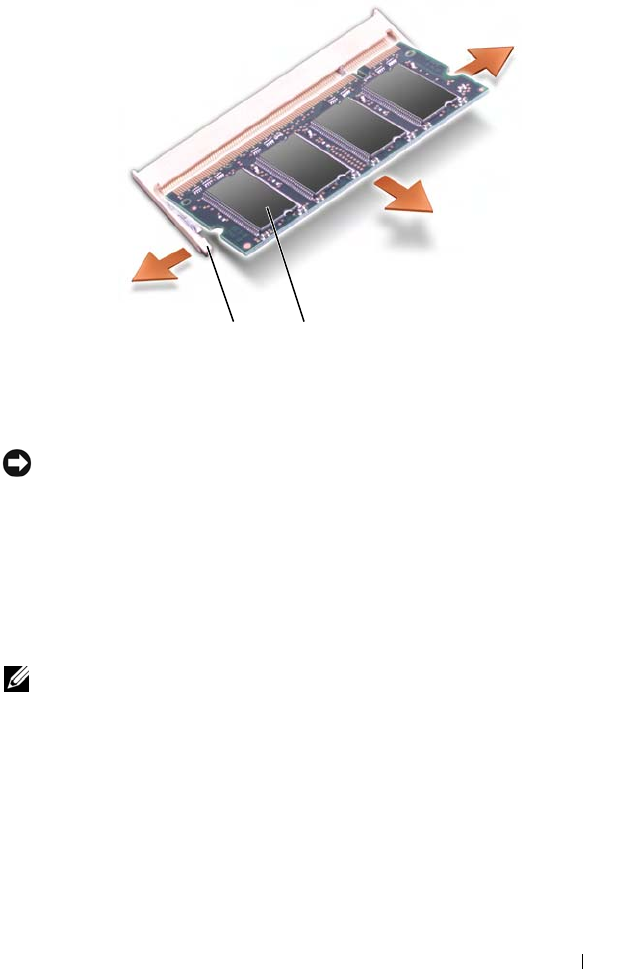
Adding and Replacing Parts 151
Replacing the DIMM B Memory Module
NOTICE: To avoid electrostatic discharge, ground yourself by using a wrist
grounding strap or by periodically touching an unpainted metal surface (such as a
connector on the back of the computer).
1
Align the notch in the module edge connector with the tab in the
connector slot.
2
Slide the module firmly into the slot at a 45-degree angle, and rotate the
module down until it clicks into place. If you do not feel the click, remove
the module and reinstall it.
NOTE: If the memory module is not installed properly, the computer may not boot.
No error message indicates this failure.
1 securing clips (2) 2 memory module
1 2
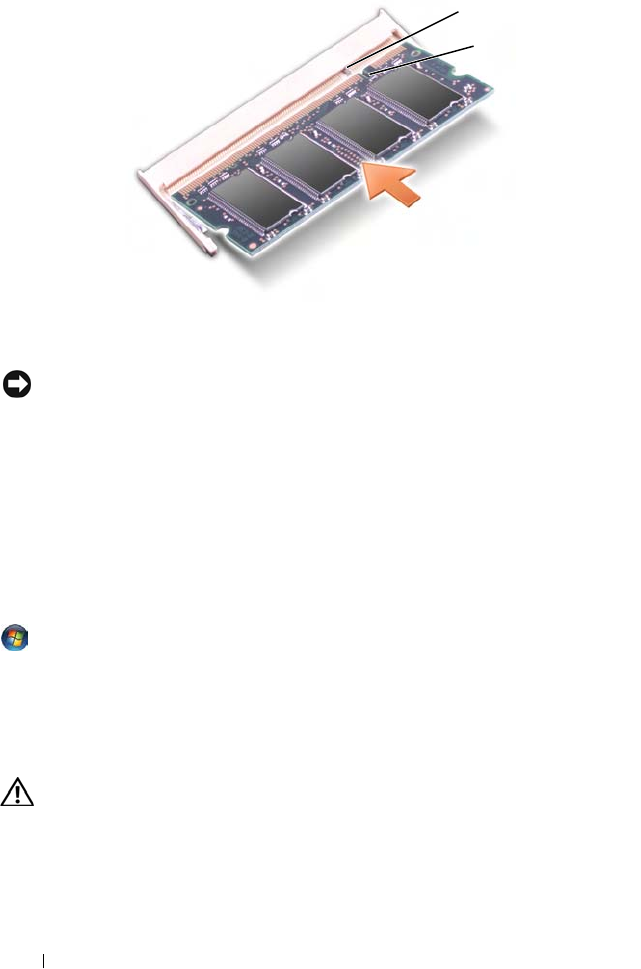
152 Adding and Replacing Parts
NOTICE: If the cover is difficult to close, remove the module and reinstall it. Forcing
the cover to close may damage your computer.
3
Replace the memory module cover.
4
Insert the battery into the battery bay, or connect the AC adapter to your
computer and an electrical outlet.
5
Turn on the computer.
As the computer boots, it detects the additional memory and automatically
updates the system configuration information.
To confirm the amount of memory installed in the computer, click Start
→
Help and Support
→
Dell System Information.
Subscriber Identity Module
Subscriber Identity Modules (SIM) identify users uniquely through an
International Mobile Subscriber Identity.
CAUTION: Before you begin any of the procedures in this section, follow the
safety instructions in the Product Information Guide.
1 tab 2 notch
1
2
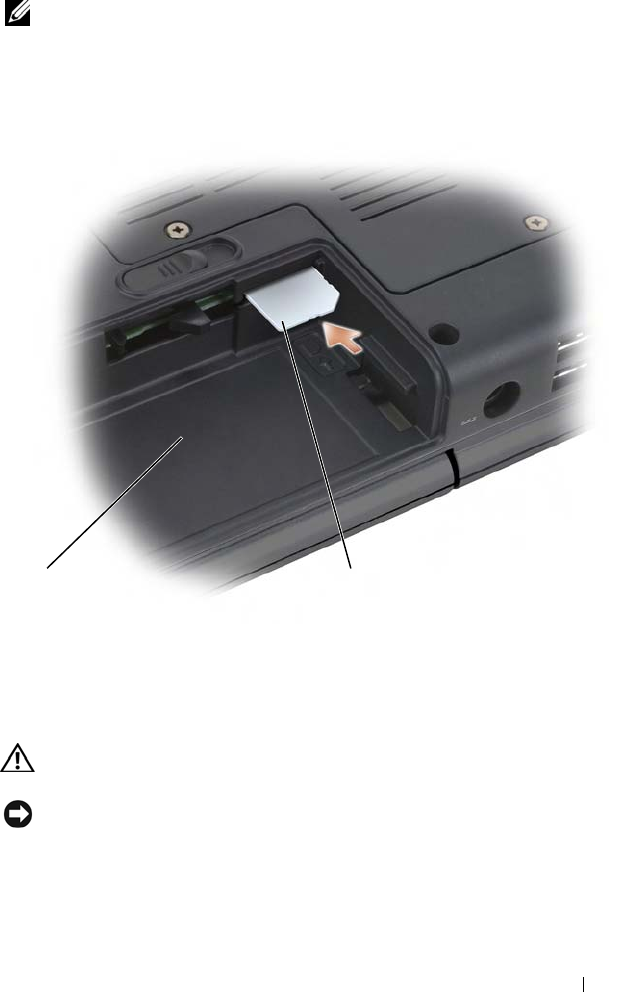
Adding and Replacing Parts 153
NOTE: Only GSM (HSDPA) type cards need a SIM. EVDO cards do not use a SIM.
1
Follow the procedures in "Before You Begin" on page 137.
2
In the battery bay, slide the SIM into the compartment with the cut-off
corner of the card facing away from the compartment.
Wireless Mini Cards
CAUTION: Before you begin any of the procedures in this section, follow the
safety instructions in the Product Information Guide.
NOTICE: To help prevent damage to the system board, you must remove the battery
from the battery bay before you begin working inside the computer.
If you ordered a wireless Mini Card with your computer, the card is already
installed. Your computer supports three types of wireless Mini Cards:
• Wireless Local Area Network (WLAN)
1 battery bay 2 SIM
1 2
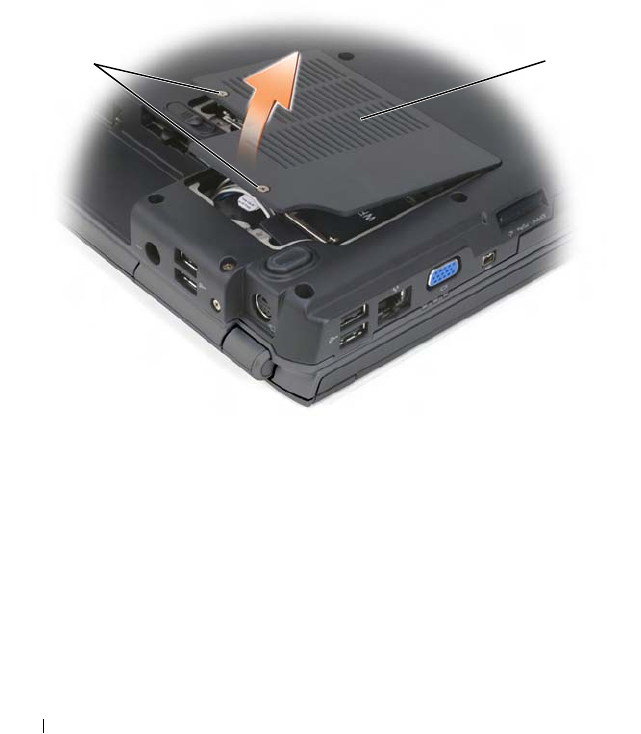
154 Adding and Replacing Parts
• Mobile Broadband or Wireless Wide Area Network (WWAN)
• Wireless Personal Area Network (WPAN)
Removing a WLAN Card
1
Follow the procedures in "Before You Begin" on page 137.
2
Turn the computer over.
3
Loosen the captive screws on the cover of the Mini Card compartment and
remove the cover.
1 captive screws (2) 2 cover
12
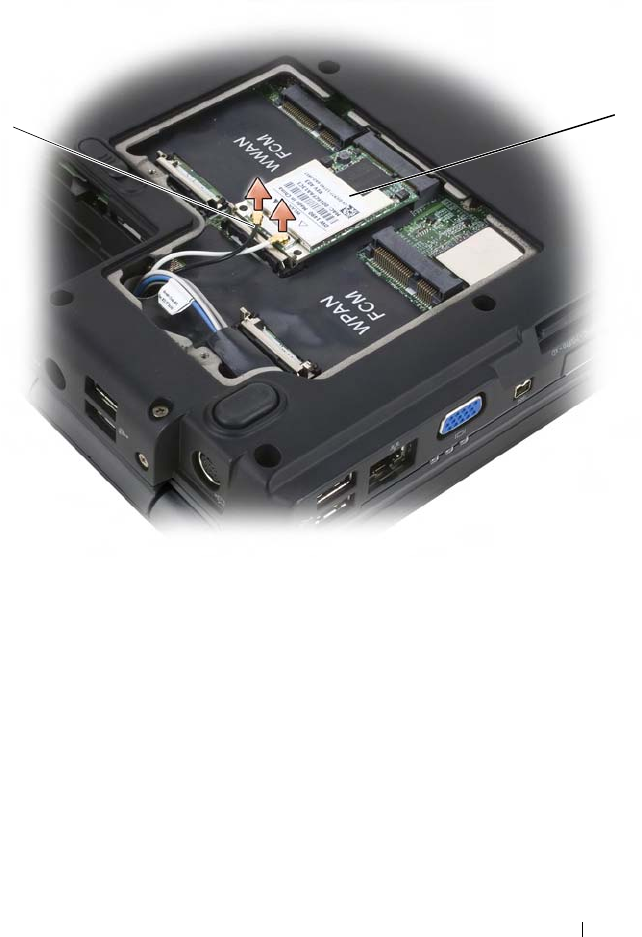
Adding and Replacing Parts 155
4
Disconnect the antenna cables from the
WLAN
card.
5
Release the
WLAN
card by pushing the metal securing tabs toward the
back of the computer until the card pops up slightly.
6
Lift the
WLAN card
out of its system board connector.
1 antenna cable connectors (2) 2 WLAN card
12
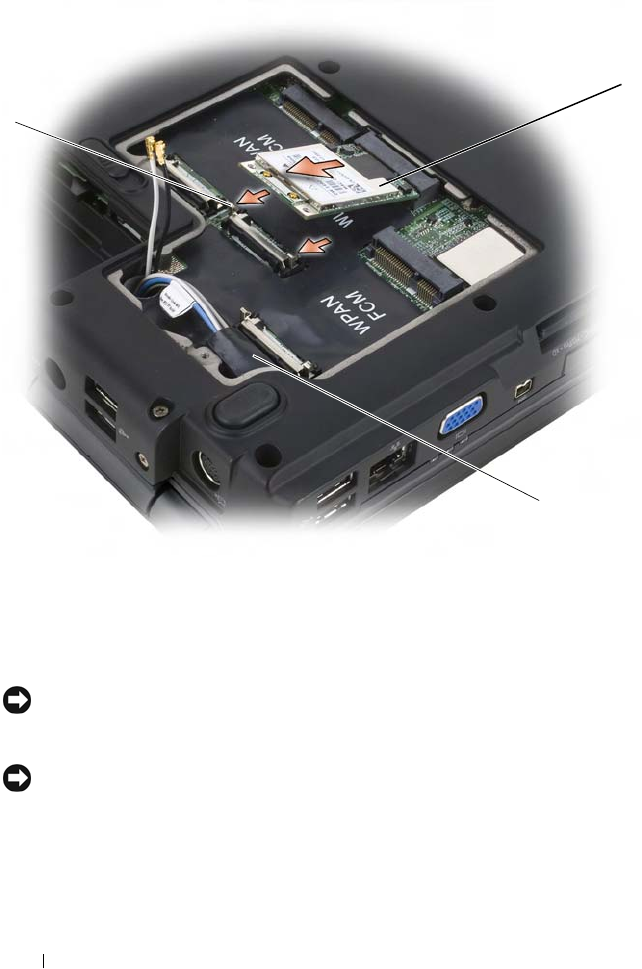
156 Adding and Replacing Parts
Replacing a WLAN Card
NOTICE: The connectors are keyed to ensure correct insertion. If you feel
resistance, check the connectors on the card and on the system board, and realign
the card.
NOTICE: To avoid damage to the WLAN card, never place cables under the card.
1
Insert the
WLAN
card connector into the system board connector labeled
"WLAN" at a 45-degree angle.
2
Press the other end of the
WLAN
card down into the securing tabs until
the card clicks into place.
1 metal securing tabs (2) 2 WLAN card
3 mylar sleeve
1
2
3

Adding and Replacing Parts 157
3
Connect the appropriate antenna cables to the
WLAN
card you are
installing:
If the WLAN card has two triangles on the label (white and black),
connect the white antenna cable to the connector labeled "main" (white
triangle), and connect the black antenna cable to the connector labeled
"aux" (black triangle).
If the WLAN card has three triangles on the label (white, black, and gray),
connect the white antenna cable to the white triangle, connect the black
antenna cable to the black triangle, and connect the gray antenna cable to
the gray triangle.
4
Secure unused antenna cables in the protective mylar sleeve.
5
Replace the cover and tighten the captive screws.
Removing a Mobile Broadband or WWAN Card
NOTE: WWAN is also available on an ExpressCard (see "Using ExpressCards" on
page 77).
1
Follow the procedures in "Before You Begin" on page 137.
2
Turn the computer over.
3
Loosen the captive screws on the cover of the Mini Card compartment and
remove the cover.
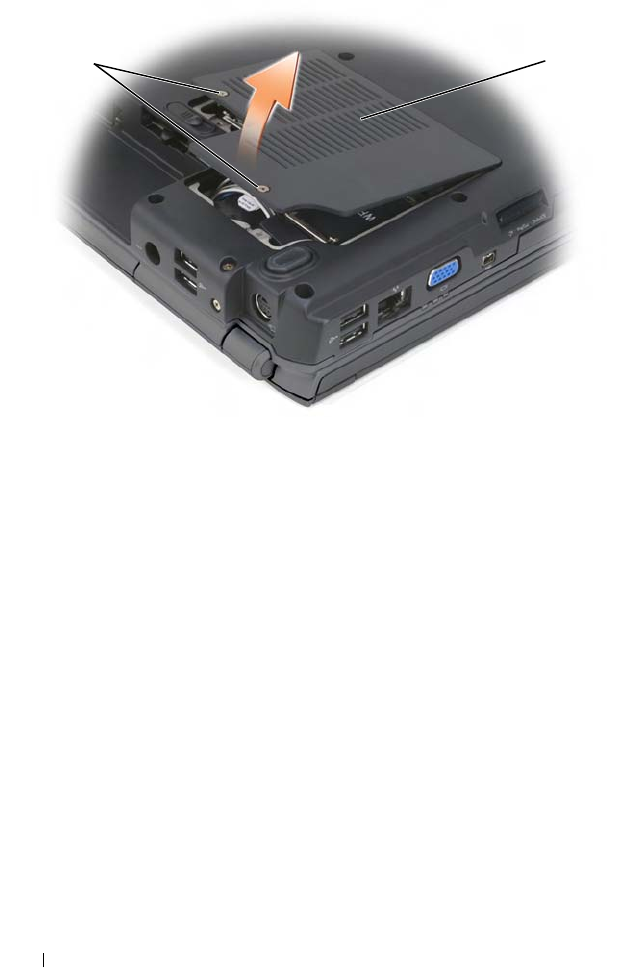
158 Adding and Replacing Parts
1 captive screws (2) 2 cover
12
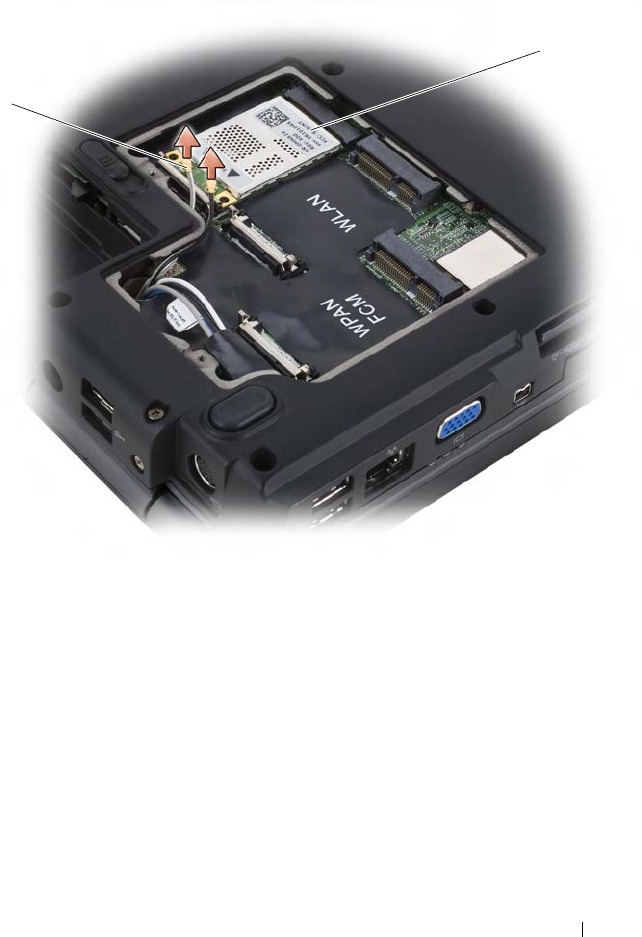
Adding and Replacing Parts 159
4
Disconnect the two antenna cables from the
WWAN
card.
5
Release the
WWAN
card by pushing the metal securing tabs toward the
back of the computer until the card pops up slightly.
6
Lift the
WWAN card
out of its system board connector.
1 antenna cable connectors (2) 2 WWAN card
1
2
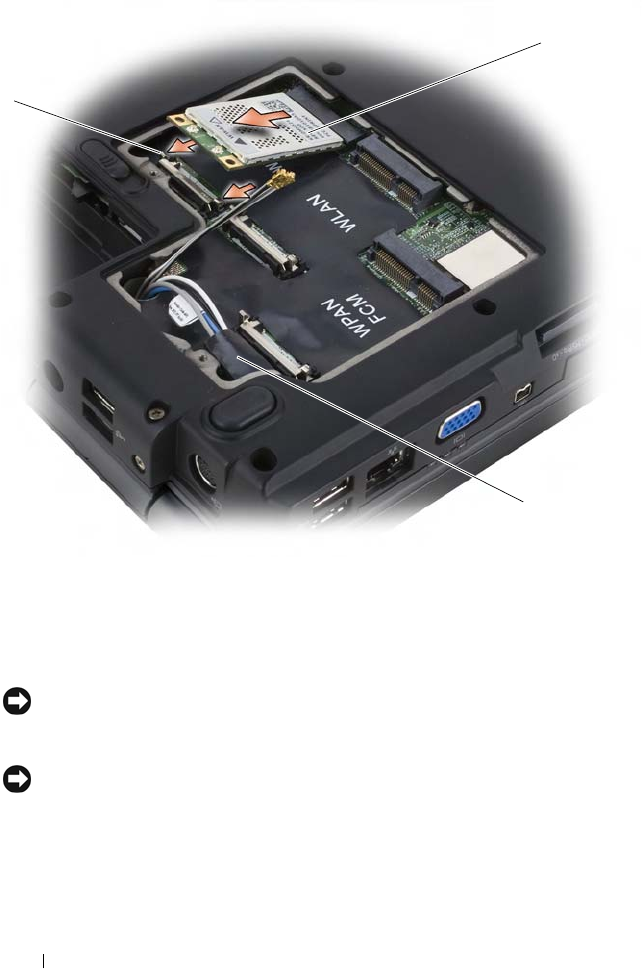
160 Adding and Replacing Parts
Replacing a WWAN Card
NOTICE: The connectors are keyed to ensure correct insertion. If you feel
resistance, check the connectors on the card and on the system board, and realign
the card.
NOTICE: To avoid damage to the WWAN card, never place cables under the card.
1
Insert the
WWAN
card connector into the system board connector labeled
"WWAN" at a 45-degree angle.
2
Press the other end of the
WWAN
card down into the securing tabs until
the card clicks into place.
1 metal securing tabs (2) 2 WWAN card
3 mylar sleeve
1
2
3
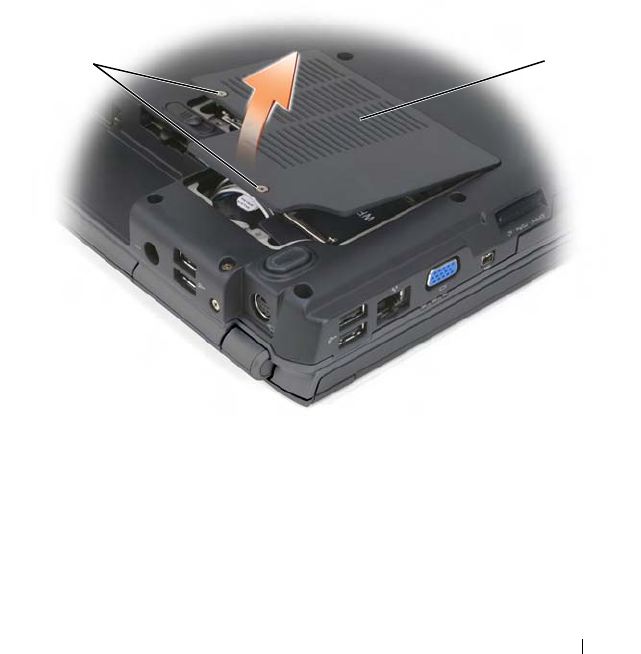
Adding and Replacing Parts 161
3
Connect the black antenna cable with a gray stripe to the connector
labeled "aux" (black triangle) and connect the white antenna cable with a
gray stripe to the connector labeled "main" (white triangle).
4
Secure unused antenna cables in the protective mylar sleeve.
5
Replace the cover and tighten the captive screws.
Removing a WPAN Card
1
Follow the procedures in "Before You Begin" on page 137.
2
Turn the computer over.
3
Loosen the captive screws on the cover of the Mini Card compartment and
remove the cover.
4
Disconnect the blue antenna cable from the
WPAN
card.
5
Release the
WPAN
card by pushing the metal securing tabs toward the
back of the computer until the card pops up slightly.
6
Lift the
WPAN card
out of its system board connector.
1 captive screws (2) 2 cover
12

162 Adding and Replacing Parts
Replacing a WPAN Card
NOTICE: The connectors are keyed to ensure correct insertion. If you feel
resistance, check the connectors on the card and on the system board, and realign
the card.
NOTICE: To avoid damage to the WPAN card, never place cables under the card.
1
Insert the
WPAN
card connector into the system board connector labeled
"WPAN" at a 45-degree angle.
2
Press the other end of the
WPAN
card down into the securing tabs until
the card clicks into place.
3
Connect the blue antenna cable to the
WPAN
card.
4
Secure unused antenna cables in the protective mylar sleeve.
5
Replace the cover and tighten the captive screws.
Flash Cache Module
The Flash Cache Module (FCM) is an internal flash drive that helps improve
the performance of your computer. If you ordered an FCM with your
computer, the card is already installed.
Removing the FCM
1
Follow the procedures in "Before You Begin" on page 137.
2
Turn the computer over and remove the cover on the Mini Card
compartment.
3
Ground yourself by touching one of the metal connectors on the back of
the computer.
NOTE: If you leave the area, ground yourself again when you return to the
computer.
4
Release the FCM by pushing the metal securing brackets away from the
card until the card pops up slightly.
5
Remove the FCM.
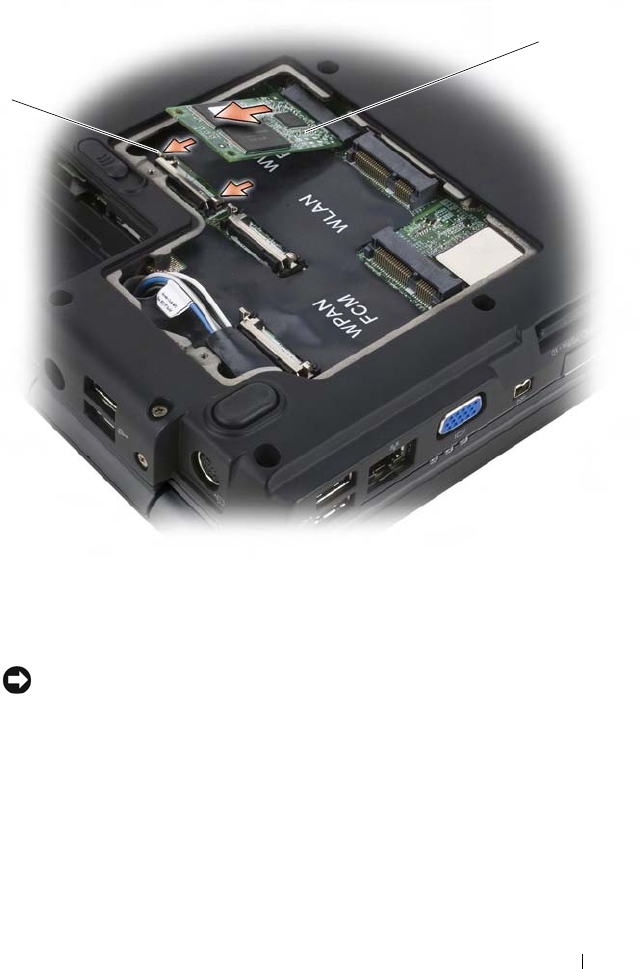
Adding and Replacing Parts 163
Replacing the FCM
NOTICE: Install the FCM in the WWAN or WPAN slot. Do not install an FCM in the
WLAN card slot. Doing so may cause damage to your computer.
1
Insert the
FCM
connector into the system board connector at a 45-degree
angle
2
Press the other end of the
FCM
down into the securing tabs until the card
clicks into place.
1 metal securing tabs (2) 2 FCM
1
2

164 Adding and Replacing Parts
Internal Card With Bluetooth® Wireless
Technology
CAUTION: Before you begin any of the procedures in this section, follow the
safety instructions in the Product Information Guide.
NOTICE: To avoid electrostatic discharge, ground yourself by using a wrist
grounding strap or by periodically touching an unpainted metal surface (such as a
connector on the back of the computer).
NOTICE: To help prevent damage to the system board, you must remove the battery
from the battery bay before you begin working inside the computer.
If you ordered a card with Bluetooth wireless technology with your computer,
it is already installed.
Removing the Card
1
Follow the procedures in "Before You Begin" on page 137.
2
Remove the hinge cover (see "Hinge Cover" on page 143).
3
Disconnect the cable on the card.
4
Grasp the connector end of the card and slide it out from under the
securing tabs.
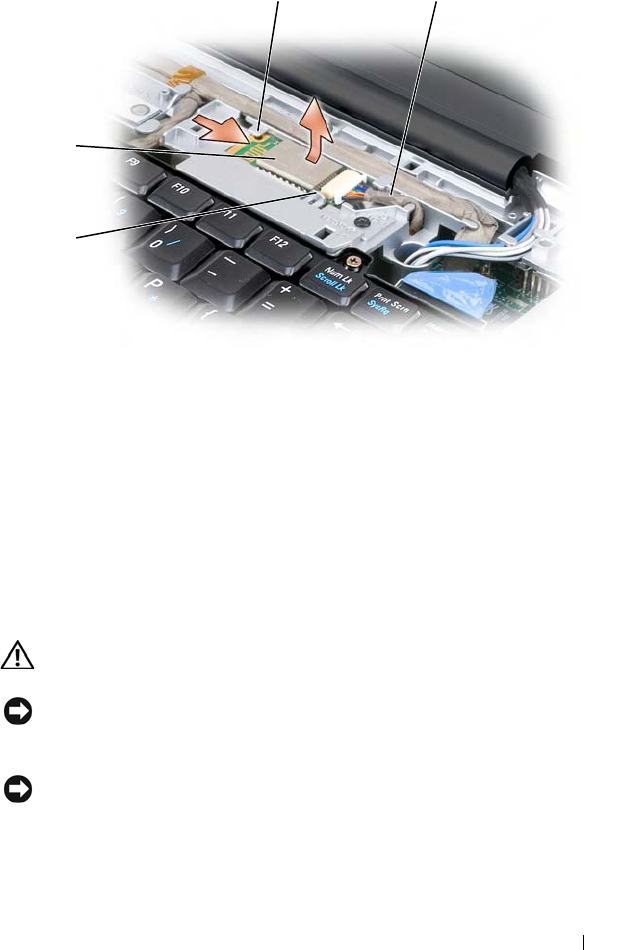
Adding and Replacing Parts 165
Replacing the Card
1
Replace the card at an angle to slide it under the securing tabs in the card
compartment.
2
Connect the cable to the card.
Coin-Cell Battery
CAUTION: Before you begin any of the procedures in this section, follow the
safety instructions in the Product Information Guide.
NOTICE: To avoid electrostatic discharge, ground yourself by using a wrist
grounding strap or by periodically touching an unpainted metal surface (such as a
connector on the back of the computer).
NOTICE: To help prevent damage to the system board, you must remove the battery
from the battery bay before you begin working inside the computer.
1 securing tab 2 card
3 securing tab 4 cable
1
4
2
3
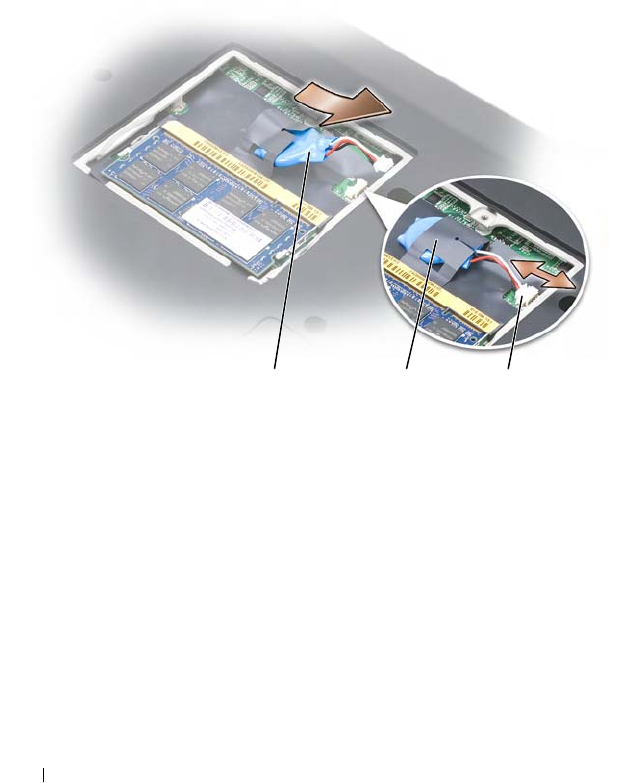
166 Adding and Replacing Parts
Removing the Coin-Cell Battery
1
Follow the procedures in "Before You Begin" on page 137.
2
Turn the computer over.
3
Loosen the captive screw on the memory module/coin-cell battery cover
(see "Bottom View" on page 31), and remove the cover.
4
Disconnect the coin-cell battery cable from the system board.
5
Slide the battery out of the mylar sleeve.
Replacing the Coin-Cell Battery
1
Connect the coin-cell battery cable to the system board.
2
Slide the coin-cell battery into the mylar sleeve.
3
Replace the cover and tighten the captive screw.
1 coin-cell battery 2 mylar sleeve
3 battery cable connector
21 3

Dell™ QuickSet Features 167
Dell™ QuickSet Features
NOTE: This feature may not be available on your computer.
Dell QuickSet provides you with easy access to configure or view the
following types of settings:
• Network connectivity
• Power management
• Display
• System information
Depending on what you want to do in Dell QuickSet, you can start it by
either clicking,double-clicking, or right-clicking the QuickSet icon in the
Microsoft® Windows® notification area. The notification area is located in
the lower-right corner of your screen.
For more information about QuickSet, right-click the QuickSet icon and
select Help.

168 Dell™ QuickSet Features

Traveling With Your Computer 169
Traveling With Your Computer
Identifying Your Computer
• Attach a name tag or business card to the computer.
• Write down your Service Tag and store it in a safe place away from the
computer or carrying case. Use the Service Tag if you need to report a loss
or theft to law enforcement officials and to Dell.
• Create a file on the Microsoft
®
Windows
®
desktop called
if_found
. Place
information such as your name, address, and phone number in this file.
• Contact your credit card company and ask if it offers coded identification
tags.
Packing the Computer
• Remove any external devices attached to the computer and store them in a
safe place.
• Fully charge the main battery and any spare batteries that you plan to carry
with you.
• Shut down the computer.
• Disconnect the AC adapter.
NOTICE: When the display is closed, extraneous items on the keyboard or palm
rest could damage the display.
• Remove any extraneous items, such as paper clips, pens, and paper, from
the keyboard and palm rest and close the display.
• Use the optional Dell carrying case to pack the computer and its
accessories together safely.
• Avoid packing the computer with items such as shaving cream, colognes,
perfumes, or food.
NOTICE: If the computer has been exposed to extreme temperatures, allow it to
acclimate to room temperature for 1 hour before turning it on.

170 Traveling With Your Computer
• Protect the computer, the batteries, and the hard drive from hazards such
as extreme temperatures and overexposure to sunlight, dirt, dust, or
liquids.
• Pack the computer so that it does not slide around in the trunk of your car
or in an overhead storage compartment.
Travel Tips
NOTICE: Do not move the computer while using the optical drive to prevent loss of
data.
NOTICE: Do not check the computer as baggage.
• Consider disabling wireless activity on your computer to maximize battery
operating time. To disable wireless activity, use the wireless switch (see
"wireless switch
" on page 25).
• Consider changing your power management options to maximize battery
operating time (see "Configuring Power Management Settings" on
page 50).
• If you are traveling internationally, carry proof of ownership—or of your
right to use the computer if it is company-owned—to speed your passage
through customs. Investigate the customs regulations of the countries you
plan to visit, and consider acquiring an international carnet (also known as
amerchandise passport) from your government.
• Find out what type of electrical outlets are used in the countries you will
visit, and have appropriate power adapters.
• Check with your credit card company for information about the kinds of
emergency travel assistance it offers to users of portable computers.
Traveling by Air
NOTICE: Do not walk the computer through a metal detector. Send the computer
through an X-ray machine or have it hand-inspected.
• Ensure that you have a charged battery available in case you are asked to
turn on the computer.
• Prior to entering the airplane, verify that using a computer is permitted.
Some airlines forbid the use of electronic devices during flight. All airlines
forbid the use of electronic devices during takeoff and landing.

Getting Help 171
Getting Help
Obtaining Assistance
CAUTION: If you need to remove the computer cover, first disconnect the
computer power and modem cables from all electrical outlets.
If you experience a problem with your computer, you can complete the
following steps to diagnose and troubleshoot the problem:
1
See "Troubleshooting" on page 99 for information and procedures that
pertain to the problem your computer is experiencing.
2
See "Dell Diagnostics" on page 99 for procedures on how to run Dell
Diagnostics.
3
Fill out the "Diagnostics Checklist" on page 176.
4
Use Dell's extensive suite of online services available at Dell Support
(
support.dell.com
) for help with installation and troubleshooting
procedures. See "Online Services" on page 172 for a more extensive list of
Dell Support online.
5
If the preceding steps have not resolved the problem, see "Contacting
Dell" on page 177.
NOTE: Call Dell Support from a telephone near or at the computer so that the
support staff can assist you with any necessary procedures.
NOTE: Dell's Express Service Code system may not be available in all countries.
When prompted by Dell's automated telephone system, enter your Express
Service Code to route the call directly to the proper support personnel. If you
do not have an Express Service Code, open the Dell Accessories folder,
double-click the Express Service Code icon, and follow the directions.
For instructions on using the Dell Support, see "Technical Support and
Customer Service" on page 172.
NOTE: Some of the following services are not always available in all locations
outside the continental U.S. Call your local Dell representative for information on
availability.

172 Getting Help
Technical Support and Customer Service
Dell's support service is available to answer your questions about Dell™
hardware. Our support staff uses computer-based diagnostics to provide fast,
accurate answers.
To contact Dell's support service, see "Before You Call" on page 175, and then
see "Contacting Dell" on page 177.
DellConnect
DellConnect is a simple online access tool that allows a Dell service and
support associate to access your computer through a broadband connection,
diagnose your problem and repair it all under your supervision. For more
information, go to support.dell.com and click DellConnect.
Online Services
You can learn about Dell products and services on the following websites:
www.dell.com
www.dell.com/ap
(Asian/Pacific countries only)
www.dell.com/jp
(Japan only)
www.euro.dell.com
(Europe only)
www.dell.com/la
(Latin American and Caribbean countries)
www.dell.ca
(Canada only)
You can access Dell Support through the following websites and e-mail
addresses:
• Dell Support websites
support.dell.com
support.jp.dell.com
(Japan only)
support.euro.dell.com
(Europe only)
• Dell Support e-mail addresses
mobile_support@us.dell.com
support@us.dell.com

Getting Help 173
la-techsupport@dell.com (Latin America and Caribbean countries only)
apsupport@dell.com (Asian/Pacific countries only)
• Dell Marketing and Sales e-mail addresses
apmarketing@dell.com (Asian/Pacific countries only)
sales_canada@dell.com (Canada only)
• Anonymous file transfer protocol (FTP)
ftp.dell.com
Log in as user:
anonymous
, and use your e-mail address as your password.
AutoTech Service
Dell's automated support service—AutoTech—provides recorded answers to
the questions most frequently asked by Dell customers about their portable
and desktop computers.
When you call AutoTech, use your touch-tone telephone to select the
subjects that correspond to your questions. For the telephone number to call
for your region, see "Contacting Dell" on page 177.
Automated Order-Status Service
To check on the status of any Dell products that you have ordered, you can go
to support.dell.com, or you can call the automated order-status service. A
recording prompts you for the information needed to locate and report on
your order. For the telephone number to call for your region, see "Contacting
Dell" on page 177.
Problems With Your Order
If you have a problem with your order, such as missing parts, wrong parts, or
incorrect billing, contact Dell for customer assistance. Have your invoice or
packing slip handy when you call. For the telephone number to call for your
region, see "Contacting Dell" on page 177.

174 Getting Help
Product Information
If you need information about additional products available from Dell, or if
you would like to place an order, visit the Dell website at www.dell.com. For
the telephone number to call for your region or to speak to a sales specialist,
see "Contacting Dell" on page 177.
Returning Items for Warranty Repair or Credit
Prepare all items being returned, whether for repair or credit, as follows:
1
Call Dell to obtain a Return Material Authorization Number, and write it
clearly and prominently on the outside of the box.
For the telephone number to call for your region, see "Contacting Dell" on
page 177.
2
Include a copy of the invoice and a letter describing the reason for the
return.
3
Include a copy of the Diagnostics Checklist (see "Diagnostics Checklist"
on page 176), indicating the tests that you have run and any error
messages reported by the Dell Diagnostics (see "Dell Diagnostics" on
page 99).
4
Include any accessories that belong with the item(s) being returned
(power cables, software floppy disks, guides, and so on) if the return is for
credit.
5
Pack the equipment to be returned in the original (or equivalent) packing
materials.
You are responsible for paying shipping expenses. You are also responsible for
insuring any product returned, and you assume the risk of loss during
shipment to Dell. Collect On Delivery (C.O.D.) packages are not accepted.
Returns that are missing any of the preceding requirements will be refused at
Dell’s receiving dock and returned to you.

Getting Help 175
Before You Call
NOTE: Have your Express Service Code ready when you call. The code helps Dell’s
automated-support telephone system direct your call more efficiently. You may also
be asked for your Service Tag (located on the back or bottom of your computer).
Remember to fill out the Diagnostics Checklist (see "Diagnostics Checklist"
on page 176). If possible, turn on your computer before you call Dell for
assistance and call from a telephone at or near the computer. You may be
asked to type some commands at the keyboard, relay detailed information
during operations, or try other troubleshooting steps possible only at the
computer itself. Ensure that the computer documentation is available.
CAUTION: Before working inside your computer, follow the safety instructions in
your Product Information Guide.

176 Getting Help
Diagnostics Checklist
Name:
Date:
Address:
Phone number:
Service Tag (bar code on the back or bottom of the computer):
Express Service Code:
Return Material Authorization Number (if provided by Dell support technician):
Operating system and version:
Devices:
Expansion cards:
Are you connected to a network? Yes No
Network, version, and network adapter:
Programs and versions:
See your operating system documentation to determine the contents of the
system’s start-up files. If the computer is connected to a printer, print each file.
Otherwise, record the contents of each file before calling Dell.
Error message, beep code, or diagnostic code:
Description of problem and troubleshooting procedures you performed:

Getting Help 177
Contacting Dell
NOTE: If you do not have an active Internet connection, you can find contact
information on your purchase invoice, packing slip, bill, or Dell product catalog.
Dell provides several online and telephone-based support and service options.
Availability varies by country and product, and some services may not be
available in your area. To contact Dell for sales, technical support, or
customer service issues:
1
Visit
support.dell.com
.
2
Verify your country or region in the
Choose A Country/Region
drop-down
menu at the bottom of the page.
3
Click
Contact Us
on the left side of the page.
4Select the appropriate service or support link based on your need.
5
Choose the method of contacting Dell that is convenient for you.

178 Getting Help

Specifications 179
Specifications
NOTE: Offerings may vary by region. For more information regarding the
configuration of your computer, click Start , click Help and Support, and then
select the option to view information about your computer.
Processor
Processor type Intel® Core™ 2 Duo
L1 cache 32 KB per instruction
32 KB data cache per core
L2 cache 2 MB or 4 MB per core depending on model
Front side bus frequency 533 MHz and 800 MHz
System Information
System chipset Intel 965 Express Chipset Family
Data bus width 64 bits
DRAM bus width dual-channel (2) 64-bit buses
Processor address bus width 32 bits
Flash EPROM 1 MB
Graphics bus PCI-E X16
PCI bus
(PCI-Express used for video
controllers)
32 bits
x16
ExpressCard
NOTE: The ExpressCard slot is designed only for ExpressCards. It does NOT support
PC Cards.
NOTE: PCMCIA may not be available in some regions.
ExpressCard controller Intel ICH8M
ExpressCard connector one ExpressCard slot (54 mm)

180 Specifications
Cards supported ExpressCard/34 (34 mm)
ExpressCard/54 (54 mm)
1.5 V and 3.3 V
ExpressCard connector size 26 pins
8-in-1 Memory Card Reader
8-in-1 memory card controller Ricoh R5C833
8-in-1 memory card connector 8-in-1 combo card connector
Cards supported
• Secure Digital (SD)
•SDIO
• MultiMediaCard (MMC)
• Memory Stick
• Memory Stick PRO
• xD-Picture Card
• Hi Speed-SD
• Hi Density-SD
Memory
Memory module connector two user-accessible SoDIMM connectors
Memory module capacities 512 MB, 1 GB, 2 GB
Memory type 667 MHz SoDIMM DDR2
Minimum memory 512 MB
Maximum memory 4 GB
NOTE: In order to take advantage of the dual channel bandwidth capability, both
memory slots must be populated and must match in size.
NOTE: The available memory displayed does not reflect the complete maximum
memory installed because some memory is reserved for system files.
Ports and Connectors
Audio microphone connector, stereo
headphone/speakers connector
ExpressCard (continued)

Specifications 181
IEEE 1394 4-pin serial connector
Consumer IR sensor compatible with Philips RC6 (receive
only)
Mini Card three Type IIIA Mini Card slots
Modem RJ-11 port
Network adapter RJ-45 port
S-video TV-out 7-pin mini-DIN connector (optional S-video
to composite video adapter cable)
USB four 4-pin USB 2.0-compliant connector
Video 15-hole connector
Communications
Modem:
Ty p e
v.92 56K MDC
Controller
softmodem
Interface
Intel High-Definition Audio
Network adapter 10/100 Ethernet LAN on system board
Wireless internal WLAN, WWAN, WPAN Mini
Cards
WWAN ExpressCard
Bluetooth® wireless technology
Video
NOTE: Optional video controller upgrades are available for your computer subject to
availability at the time of purchase. To determine the configuration of your computer,
see "Determining Your Computer’s Configuration" on page 19.
Video type: integrated on system board
Video controller
Intel 965 GM
Video memory
dynamic based on system memory capacity
LCD interface
LVDS
Ports and Connectors (continued)

182 Specifications
TV support
NTSC or PAL in S-video, composite, and
component modes
Video type: discrete video card
Data bus
PCI Express X16
Video controller
nVIDIA GeForce 8400M GS or nVIDIA
GeForce 8600M GT
Video memory
128 MB (GeForce 8400M GS) or 256 MB
(GeForce 8600M GT)
LCD interface
LVDS
TV support
NTSC or PAL in S-video, composite, and
component modes
Audio
Audio type two-channel high-definition stereo
Audio controller Sigmatel STAC9205 High Definition Audio
codec
Stereo conversion 24-bit (analog-to-digital and digital-to-
analog)
Interfaces:
Internal
Intel High Definition Audio
External
microphone-in connector, stereo
headphones/speakers connector
Speaker two 4-ohm speakers
Internal speaker amplifier 2 Watts per channel into 4 ohms
Internal microphone Dual digital microphone array
Volume controls program menus, media control buttons
Video (continued)

Specifications 183
Display
Type (active-matrix TFT) 15.4-inch WXGA
15.4-inch WXGA with TrueLife
15.4-inch WXGA+ with TrueLife
15.4-inch WSXGA+ with TrueLife

184 Specifications
Dimensions:
Height
222.5 mm (8.8 in)
Width
344.5 mm (13.6 in)
Diagonal
391.2 mm (15.4 in)
Maximum resolutions:
WXGA
1280 x 800 at 262 K colors
WXGA with TrueLife
1280 x 800 at 262 K colors
WXGA+ with TrueLife
1440 x 900 at 262 K colors
WSXGA+ with TrueLife
1680 x 1050 at 262 K colors
Refresh rate 60 Hz
Operating angle 0° (closed) to 155°
Viewing angles:
Horizontal
±40° (WXGA)
±40° (WXGA
with TrueLife
)
±55° (WXGA+
with TrueLife
)
±60° (WSXGA+
with TrueLife
)
Vertical
+15°/–30° (WXGA)
+15°/–30° (WXGA
with TrueLife)
±45° (WXGA+
with TrueLife
)
+40°/–50° (WSXGA+
with TrueLife
)
Pixel pitch:
WXGA
0.258 mm
WXGA with TrueLife
0.258 mm
WXGA+ with TrueLife
0.2304 mm
WSXGA+ with TrueLife
0.197 mm
Controls brightness can be controlled through
keyboard shortcuts (see "Display Functions"
on page 42)
Display (continued)

Specifications 185
Keyboard
Number of keys 87 (U.S. and Canada); 88 (Europe); 91
(Japan)
Layout QWERTY/AZERTY/Kanji
Touch Pad
X/Y position resolution
(graphics table mode) 240 cpi
Size:
Width
71.7-mm (2.8-in) sensor-active area
Height
34.0-mm (1.3-in) rectangle
Battery
Type 9-cell "smart" lithium ion
6-cell "smart" lithium ion
Dimensions:
Depth
67.6 mm (2.66 in) (9 cell)
47.5 mm (1.87 in) (6 cell)
Height
20.4 mm (0.8 in)
Width
209.9 mm (8.26 in)
Weight 0.48 kg (1.06 lb) (9 cell)
0.33 kg (0.7 lb) (6 cell)
Voltage 11.1 VDC
Charge time (approximate):
Computer off
4 hours
Operating time Battery operating time varies depending on
operating conditions and can be significantly
reduced under certain power-intensive
conditions (see "Power Problems" on
page 120).
See "Using a Battery" on page 47 for more
information on battery life.

186 Specifications
Life span (approximate) 300 discharge/charge cycles
Temperature range:
Operating
0° to 35°C (32° to 95°F)
Storage
–40° to 65°C (–40° to 149°F)
Coin-cell battery
CR-2032
AC Adapter
Input voltage 90–264 VAC
Input current (maximum) 1.5 A
Input frequency 47–63 Hz
Output current (65 W) 4.34 A (maximum at 4-second pulse)
3.34 A (continuous)
Output current (90 W) 5.62 A (maximum at 4-second pulse)
4.62 A (continuous)
NOTE: If your computer has the discrete video configuration, you must use the 90 W
AC adapter that is shipped with your computer. Using the incorrect AC adapter will
prevent optimal system performance and produce a BIOS warning.
Output power 65 W, 90 W
Rated output voltage 19.5 +/– 1.0 VDC
Dimensions (65 W):
Height
28.2 mm (1.11 in)
Width
57.9 mm (2.28 in)
Depth
137.2 mm (5.4 in)
Weight (with cables)
0.4 kg (0.9 lb)
Dimensions (90 W):
Height
34.2 mm (1.34 in)
Width
60.8 mm (2.39 in)
Depth
153.4 mm (6.0 in)
Weight (with cables)
0.46 kg (1.01 lb)
Battery (continued)

Specifications 187
Temperature range:
Operating
0° to 35°C (32° to 95°F)
Storage
–40° to 65°C (–40° to 149°F)
Physical
Height 42 mm (1.65 in)
Width 358.7 mm (14.12 in)
Depth 269 mm (10.59 in)
Weight (with 6-cell battery):
Configurable to less than
3.0 kg (6.61 lb)
Environmental
Temperature range:
Operating
0° to 35°C (32° to 95°F)
Storage
–40° to 65°C (–40° to 149°F)
Relative humidity (maximum):
Operating
10% to 90% (noncondensing)
Storage
5% to 95% (noncondensing)
Maximum vibration (using a random
vibration spectrum that simulates
user environment):
Operating
0.66 GRMS
Storage
1.3 GRMS
Maximum shock (Measured with
hard drive in operating status and a
2-ms half-sine pulse for operating.
Also measured with hard drive in
head-parked position and a 2-ms
halfsine pulse for storage):
Operating
142 G
Storage
163 G
AC Adapter (continued)

188 Specifications
Altitude (maximum):
Operating
–15.2 to 3048 m (–50 to 10,000 ft)
Storage
–15.2 to 10,668 m (–50 to 35,000 ft)
Camera (optional)
Still Resolution 2 Mega-Pixel
Video Resolution 640 x 480 at 30 fps
Camera activation Desktop icon
Environmental (continued)

Appendix 189
Appendix
Using the System Setup Program
NOTE: Your operating system may automatically configure most of the options
available in system setup, thus overriding options that you set through system setup.
An exception is the External Hot Key option, which you can disable or enable only
through system setup. For more information on configuring features for your
operating system, see Windows Help and Support (click Start , and then click
Help and Support).
You can use system setup as follows:
• To set or change user-selectable features such as your computer password
• To verify information about the computer's current configuration such as
the amount of system memory
After you set up the computer, run system setup to familiarize yourself with
your system configuration information and optional settings. You may want
to write down the information for future reference.
The system setup screens display the current setup information and settings
for your computer, such as:
• System configuration
• Boot order
• Boot (start-up) configuration
• Basic device configuration settings
• System security and hard drive password settings
NOTE: Unless you are an expert computer user or are directed to do so by Dell
technical support, do not change the system setup settings. Certain changes might
make your computer work incorrectly.

190 Appendix
Viewing the System Setup Screen
1
Turn on (or restart) your computer.
2
When the DELL logo appears, press <F2> immediately.
If you wait too long and the Microsoft Windows logo appears, continue to
wait until you see the Windows desktop, then shut down your computer
and try again.
System Setup Screen
NOTE: For information about a specific item on a system setup screen, highlight the
item and see the Help area on the screen.
On each screen, the system setup options are listed at the left. To the right of
each option is the setting or value for that option. You can change settings
that appear as white type on the screen. Options or values that you cannot
change (because they are determined by the computer) appear less bright.
The upper-right corner of the screen displays help information for the
currently highlighted option; the lower-right corner displays information
about the computer. System setup key functions are listed across the bottom
of the screen.
Commonly Used Options
Certain options require that you reboot the computer for new settings to take
effect.
Changing the Boot Sequence
The boot sequence, or boot order, tells the computer where to look to find the
software needed to start the operating system. You can control the boot
sequence and enable/disable devices using the Boot Order page of the system
setup program.
NOTE: To change the boot sequence on a one-time-only basis, see "Performing a
One-Time Boot" on page 191.
The Boot Order page displays a general list of the bootable devices that may
be installed in your computer, including but not limited to the following:
• Diskette Drive
• Internal HDD

Appendix 191
• USB Storage Device
• CD/DVD/CD-RW drive
• Modular bay HDD
NOTE: Only devices that are preceded by a number are bootable.
During the boot routine, the computer starts at the top of the list and scans
each enabled device for the operating system start-up files. When the
computer finds the files, it stops searching and starts the operating system.
To control the boot devices, select (highlight) a device by pressing the down-
arrow or up-arrow key, and then enable or disable the device or change its
order in the list.
• To enable or disable a device, highlight the item and press the space bar.
Enabled items are preceded by a number; disabled items are not preceded
by a number.
• To reorder a device in the list, highlight the device and press <u> to move
the device up the list or <d> to move a device down the list.
Boot sequence changes take effect as soon as you save the changes and exit
the system setup program.
Performing a One-Time Boot
You can set a one-time-only boot sequence without entering the system setup
program (you can also use this procedure to boot the Dell Diagnostics on the
diagnostics utility partition on your hard drive).
1
Shut down the computer through the
Start
menu.
2
Connect the computer to an electrical outlet.
3
Turn on the computer. When the DELL logo appears, press <F12>
immediately.
If you wait too long and the Windows logo appears, continue to wait until
you see the Windows desktop, then shut down your computer and try
again.
4
When the boot device list appears, highlight the device from which you
want to boot and press <Enter>.
The computer boots to the selected device.
The next time you reboot the computer, the previous boot order is restored.

192 Appendix
Cleaning Your Computer
CAUTION: Before you begin any of the procedures in this section, follow the
safety instructions located in the Product Information Guide.
Computer, Keyboard, and Display
CAUTION: Before you clean your computer, disconnect the computer from the
electrical outlet and remove any installed batteries. Clean your computer with a
soft cloth dampened with water. Do not use liquid or aerosol cleaners, which may
contain flammable substances.
• Use a can of compressed air to remove dust from between the keys on the
keyboard and to remove any dirt or lint from the display.
NOTICE: To help prevent damage to the computer or display, do not spray cleaning
solution directly onto the display. Only use products specifically designed for
cleaning displays, and follow the instructions that are included with the product.
• Moisten a soft, lint-free cloth with either water or a display cleaner. Do not
use alcohol or an ammonia-based cleaner. Wipe the display gently working
from the center to the edges until it is clean and any fingerprints are
removed. Do not use excessive pressure.
NOTICE: To prevent damage to the antiglare coating, do not wipe the display with
soap or alcohol.
• Moisten a soft, lint-free cloth with water and wipe the computer and
keyboard. Do not allow water from the cloth to seep between the touch
pad and the surrounding palm rest.
• To clean your monitor screen, lightly dampen a soft, clean cloth with water.
You can also use a special screen-cleaning tissue or solution suitable for the
monitor’s antistatic coating.
• Wipe the keyboard, computer, and monitor plastics with a soft cleaning
cloth moistened with a solution of three parts water and one part
dishwashing detergent.
Do not soak the cloth or let water drip inside your computer or keyboard.
Touch Pad
1
Shut down and turn off your computer (see "Turning Off Your Computer"
on page 137).

Appendix 193
2
Disconnect any attached devices from the computer and from their
electrical outlets.
3
Remove any installed batteries (see "Battery Performance" on page 47).
4
Moisten a soft, lint-free cloth with water, and wipe it gently across the
surface of the touch pad. Do not allow water from the cloth to seep
between the touch pad and the surrounding palm rest.
Mouse
NOTICE: Disconnect the mouse from the computer before cleaning the mouse
If your screen cursor skips or moves abnormally, clean the mouse.
Cleaning a Non-Optical Mouse
1
Clean the outside casing of the mouse with a cloth moistened with a mild
cleaning solution.
2
Turn the retainer ring on the underside of your mouse counterclockwise,
and then remove the ball.
3
Wipe the ball with a clean, lint-free cloth.
4
Blow carefully into the ball cage or use a can of compressed air to dislodge
dust and lint.
5
If the rollers inside the ball cage are dirty, clean the rollers with a cotton
swab moistened lightly with isopropyl alcohol.
6
Recenter the rollers in their channels if they are misaligned. Ensure that
fluff from the swab is not left on the rollers.
7
Replace the ball and retainer ring, and turn the retainer ring clockwise
until it clicks into place.
Cleaning an Optical Mouse
Clean the outside casing of the mouse with a cloth moistened with a mild
cleaning solution.
Media
NOTICE: Always use compressed air to clean the lens in the optical drive, and
follow the instructions that come with the compressed air product. Never touch the
lens in the drive.

194 Appendix
If you notice problems, such as skipping, with the playback quality of your
media, try cleaning the discs.
1
Hold the disc by its outer edge. You can also touch the inside edge of the
center hole.
NOTICE: To help prevent damage to the surface, do not wipe in a circular motion
around the disc.
2
With a soft, lint-free cloth, gently wipe the bottom of the disc (the
unlabeled side) in a straight line from the center to the outer edge of the
disc.
For stubborn dirt, try using water or a diluted solution of water and mild
soap. You can also purchase commercial products that clean discs and
provide some protection from dust, fingerprints, and scratches. Cleaning
products for CDs are also safe to use on DVDs.
Dell Technical Support Policy (U.S. Only)
Technician assisted technical support requires the cooperation and
participation of the customer in the troubleshooting process and provides for
restoration of the operating system, software programs, and hardware drivers
to the original default configuration as shipped from Dell, as well as the
verification of appropriate functionality of the computer and all Dell-installed
hardware. In addition to this technician assisted technical support, online
technical support is available at support.dell.com. Additional technical
support options may be available for purchase.
Dell provides limited technical support for the computer and any "Dell-
installed" software and peripherals1. Support for third-party software and
peripherals is provided by the original manufacturer, including those
purchased and/or installed through Dell Software and Peripherals, Readyware,
and Custom Factory Integration2.
1Repair services are provided pursuant to the terms and conditions of your limited
warranty and any optional support service contract purchased with the computer.
2All Dell-standard components included in a Custom Factory Integration (CFI) project
are covered by the standard Dell limited warranty for your computer. However, Dell
also extends a parts replacement program to cover all nonstandard, third-party hard-
ware components integrated through CFI for the duration of the computer’s service
contract.

Appendix 195
Definition of "Dell-Installed" Software and Peripherals
Dell-installed software includes the operating system and some of the
software programs that are installed on the computer during the
manufacturing process (Microsoft Office, Norton Antivirus, etc).
Dell-installed peripherals include any internal expansion cards, or
Dell-branded module bay or ExpressCard accessories. In addition, any Dell-
branded monitors, keyboards, mice, speakers, microphones for telephonic
modems, docking stations/port replicators, networking products, and all
associated cabling are included.
Definition of "Third-Party" Software and Peripherals
Third-party software and peripherals include any peripheral, accessory, or
software program sold by Dell not under the Dell brand (printers, scanners,
cameras, games, etc). Support for all third-party software and peripherals is
provided by the original manufacturer of the product.
FCC Notice (U.S. Only)
FCC Class B
This equipment generates, uses, and can radiate radio frequency energy and,
if not installed and used in accordance with the manufacturer’s instruction
manual, may cause interference with radio and television reception. This
equipment has been tested and found to comply with the limits for a Class B
digital device pursuant to Part 15 of the FCC Rules.
This device complies with Part 15 of the FCC Rules. Operation is subject to
the following two conditions:
• This device may not cause harmful interference.
• This device must accept any interference received, including interference
that may cause undesired operation.
NOTICE: The FCC regulations provide that changes or modifications not expressly
approved by Dell Inc. could void your authority to operate this equipment.
These limits are designed to provide reasonable protection against harmful
interference in a residential installation. However, there is no guarantee that
interference will not occur in a particular installation. If this equipment does

196 Appendix
cause harmful interference with radio or television reception, which can be
determined by turning the equipment off and on, you are encouraged to try
to correct the interference by one or more of the following measures:
• Reorient the receiving antenna.
• Relocate the system with respect to the receiver.
• Move the system away from the receiver.
• Plug the system into a different outlet so that the system and the receiver
are on different branch circuits.
If necessary, consult a representative of Dell Inc. or an experienced
radio/television technician for additional suggestions.
The following information is provided on the device or devices covered in this
document in compliance with the FCC regulations:
Macrovision Product Notice
This product incorporates copyright protection technology that is protected
by U.S. patents and other intellectual property rights. Use of this copyright
protection technology must be authorized by Macrovision, and is intended
for home and other limited viewing uses only unless otherwise authorized by
Macrovision. Reverse engineering or disassembly is prohibited.
Product name: Dell™ Vostro™ 1500
Model number: PP22L
Company name: Dell Inc.
Worldwide Regulatory Compliance & Environmental
Affairs
One Dell Way
Round Rock, TX 78682 USA
512-338-4400

Glossary 197
Glossary
Terms in this Glossary are provided for informational purposes only and may
or may not describe features included with your particular computer.
A
AC — alternating current — The form of electricity that powers your computer when
you plug the AC adapter power cable in to an electrical outlet.
ACPI — advanced configuration and power interface — A power management
specification that enables Microsoft® Windows® operating systems to put a computer
in standby or hibernate mode to conserve the amount of electrical power allocated to
each device attached to the computer.
AGP — accelerated graphics port — A dedicated graphics port that allows system
memory to be used for video-related tasks. AGP delivers a smooth, true-color video
image because of the faster interface between the video circuitry and the computer
memory.
AHCI — Advanced Host Controller Interface — An interface for a SATA hard drive
Host Controller which allows the storage driver to enable technologies such as Native
Command Queuing (NCQ) and hot plug.
ALS — ambient light sensor — A feature that helps to control display brightness.
antivirus software — A program designed to identify, quarantine, and/or delete viruses
from your computer.
ASF — alert standards format — A standard to define a mechanism for reporting
hardware and software alerts to a management console. ASF is designed to be
platform- and operating system-independent.
B
battery life span — The length of time (years) during which a portable computer
battery is able to be depleted and recharged.
battery operating time — The length of time (minutes or hours) that a portable
computer battery powers the computer.

198 Glossary
BIOS — basic input/output system — A program (or utility) that serves as an interface
between the computer hardware and the operating system. Unless you understand
what effect these settings have on the computer, do not change them. Also referred to
as system setup.
bit — The smallest unit of data interpreted by your computer.
Bluetooth® wireless technology — A wireless technology standard for short-range (9 m
[29 feet]) networking devices that allows for enabled devices to automatically
recognize each other.
boot sequence — Specifies the order of the devices from which the computer
attempts to boot.
bootable CD — A CD that you can use to start your computer. In case your hard drive
is damaged or your computer has a virus, ensure that you always have a bootable CD
or floppy disk available. Your Drivers and Utilities media is a bootable CD.
bootable disk — A disk that you can use to start your computer. In case your hard drive
is damaged or your computer has a virus, ensure that you always have a bootable CD
or floppy disk available.
bps — bits per second — The standard unit for measuring data transmission speed.
BTU — British thermal unit — A measurement of heat output.
bus — A communication pathway between the components in your computer.
bus speed — The speed, given in MHz, that indicates how fast a bus can transfer
information.
byte — The basic data unit used by your computer. A byte is usually equal to 8 bits.
C
C — Celsius — A temperature measurement scale where 0° is the freezing point and
100° is the boiling point of water.
cache — A special high-speed storage mechanism which can be either a reserved
section of main memory or an independent high-speed storage device. The cache
enhances the efficiency of many processor operations.
L1 cache — Primary cache stored inside the processor.
L2 cache — Secondary cache which can either be external to the processor or
incorporated into the processor architecture.
carnet — An international customs document that facilitates temporary imports into
foreign countries. Also known as a merchandise passport.
CD-R — CD recordable — A recordable version of a CD. Data can be recorded only

Glossary 199
once onto a CD-R. Once recorded, the data cannot be erased or written over.
CD-RW — CD rewritable — A rewritable version of a CD. Data can be written to a
CD-RW disc, and then erased and written over (rewritten).
CD-RW drive — A drive that can read CDs and write to CD-RW (rewritable CDs)
and CD-R (recordable CDs) discs. You can write to CD-RW discs multiple times, but
you can write to CD-R discs only once.
CD-RW/DVD drive — A drive, sometimes referred to as a combo drive, that can read
CDs and DVDs and write to CD-RW (rewritable CDs) and CD-R (recordable CDs)
discs. You can write to CD-RW discs multiple times, but you can write to CD-R discs
only once.
clock speed — The speed, given in MHz, that indicates how fast computer
components that are connected to the system bus operate.
CMOS — A type of electronic circuit. Computers use a small amount of battery-
powered CMOS memory to hold date, time, and system setup options.
COA — Certificate of Authenticity — The Windows alpha-numeric code located on a
sticker on your computer. Also referred to as the Product Key or
Product ID.
Consumer IR — A port that allows you to transfer data between the computer and
infrared-compatible devices without using a cable connection.
Control Panel — A Windows utility that allows you to modify operating system and
hardware settings, such as display settings.
controller — A chip that controls the transfer of data between the processor and
memory or between the processor and devices.
CRIMM — continuity rambus in-line memory module — A special module that has
no memory chips and is used to fill unused RIMM slots.
cursor — The marker on a display or screen that shows where the next keyboard, touch
pad, or mouse action will occur. It often is a blinking solid line, an underline character,
or a small arrow.
D
DDR SDRAM — double-data-rate SDRAM — A type of SDRAM that doubles the
data burst cycle, improving system performance.
DDR2 SDRAM — double-data-rate 2 SDRAM — A type of DDR SDRAM that uses a
4-bit prefetch and other architectural changes to boost memory speed to over
400 MHz.
device — Hardware such as a disk drive, printer, or keyboard that is installed in or

200 Glossary
connected to your computer.
device driver — See driver.
DIMM — dual in-line memory module — A circuit board with memory chips that
connects to a memory module on the system board.
DIN connector — A round, six-pin connector that conforms to DIN (Deutsche
Industrie-Norm) standards; it is typically used to connect PS/2 keyboard or mouse
cable connectors.
disk striping — A technique for spreading data over multiple disk drives. Disk striping
can speed up operations that retrieve data from disk storage. Computers that use disk
striping generally allow the user to select the data unit size or stripe width.
DMA — direct memory access — A channel that allows certain types of data transfer
between RAM and a device to bypass the processor.
DMTF — Distributed Management Task Force — A consortium of hardware and
software companies who develop management standards for distributed desktop,
network, enterprise, and Internet environments.
domain — A group of computers, programs, and devices on a network that are
administered as a unit with common rules and procedures for use by a specific group
of users. A user logs on to the domain to gain access to the resources.
DRAM — dynamic random-access memory — Memory that stores information in
integrated circuits containing capacitors.
driver — Software that allows the operating system to control a device such as a
printer. Many devices do not work properly if the correct driver is not installed in the
computer.
DSL — Digital Subscriber Line — A technology that provides a constant, high-speed
Internet connection through an analog telephone line.
dual-core — An Intel® technology in which two physical computational units exist
inside a single processor package, thereby increasing computing efficiency and multi-
tasking ability.
dual display mode — A display setting that allows you to use a second monitor as an
extension of your display. Also referred to as extended display mode.
DVD-R — DVD recordable — A recordable version of a DVD. Data can be recorded
only once onto a DVD-R. Once recorded, the data cannot be erased or written over.
DVD+RW — DVD rewritable — A rewritable version of a DVD. Data can be written
to a DVD+RW disc, and then erased and written over (rewritten). (DVD+RW
technology is different from DVD-RW technology.)
DVD+RW drive — drive that can read DVDs and most CD media and write to
DVD+RW (rewritable DVDs) discs.

Glossary 201
DVI — digital video interface — A standard for digital transmission between a
computer and a digital video display.
E
ECC — error checking and correction — A type of memory that includes special
circuitry for testing the accuracy of data as it passes in and out of memory.
ECP — extended capabilities port — A parallel connector design that provides
improved bidirectional data transmission. Similar to EPP, ECP uses direct memory
access to transfer data and often improves performance.
EIDE — enhanced integrated device electronics — An improved version of the IDE
interface for hard drives and CD drives.
EMI — electromagnetic interference — Electrical interference caused by
electromagnetic radiation.
ENERGY STAR® — Environmental Protection Agency requirements that decrease
the overall consumption of electricity.
EPP — enhanced parallel port — A parallel connector design that provides
bidirectional data transmission.
ESD — electrostatic discharge — A rapid discharge of static electricity. ESD can
damage integrated circuits found in computer and communications equipment.
expansion card — A circuit board that installs in an expansion slot on the system
board in some computers, expanding the capabilities of the computer. Examples
include video, modem, and sound cards.
expansion slot — A connector on the system board (in some computers) where you
insert an expansion card, connecting it to the system bus.
ExpressCard — A removable I/O card adhering to the PCMCIA standard. Modems
and network adapters are common types of ExpressCards. ExpressCards support both
the PCI Express and USB 2.0 standard.
Express Service Code — A numeric code located on a sticker on your Dell™ computer.
Use the Express Service Code when contacting Dell for assistance. Express Service
Code service may not be available in some countries.
extended display mode — A display setting that allows you to use a second monitor as
an extension of your display. Also referred to as dual display mode.
extended PC Card — A PC Card that extends beyond the edge of the PC Card slot
when installed.

202 Glossary
F
Fahrenheit — A temperature measurement scale where 32° is the freezing point and
212° is the boiling point of water.
FBD — fully-buffered DIMM — A DIMM with DDR2 DRAM chips and an Advanced
Memory Buffer (AMB) that speeds communication between the DDR2 SDRAM chips
and the system.
FCC — Federal Communications Commission — A U.S. agency responsible for
enforcing communications-related regulations that state how much radiation
computers and other electronic equipment can emit.
fingerprint reader — A strip sensor that uses your unique fingerprint to authenticate
your user identity to help secure your computer.
folder — A term used to describe space on a disk or drive where files are organized and
grouped. Files in a folder can be viewed and ordered in various ways, such as
alphabetically, by date, and by size.
format — The process that prepares a drive or disk for file storage. When a drive or
disk is formatted, the existing information on it is lost.
FSB — front side bus — The data path and physical interface between the processor
and RAM.
FTP — file transfer protocol — A standard Internet protocol used to exchange files
between computers connected to the Internet.
G
G — gravity — A measurement of weight and force.
GB — gigabyte — A measurement of data storage that equals 1024 MB (1,073,741,824
bytes). When used to refer to hard drive storage, the term is often rounded to
1,000,000,000 bytes.
GHz — gigahertz — A measurement of frequency that equals one thousand million
Hz, or one thousand MHz. The speeds for computer processors, buses, and interfaces
are often measured in GHz.
graphics mode — A video mode that can be defined as x horizontal pixels by y vertical
pixels by z colors. Graphics modes can display an unlimited variety of shapes and
fonts.
GUI — graphical user interface — Software that interacts with the user by means of
menus, windows, and icons. Most programs that operate on the Windows operating
systems are GUIs.

Glossary 203
H
hard drive — A drive that reads and writes data on a hard disk. The terms hard drive
and hard disk are often used interchangeably.
heat sink — A metal plate on some processors that helps dissipate heat.
hibernate mode — A power management mode that saves everything in memory to a
reserved space on the hard drive and then turns off the computer. When you restart
the computer, the memory information that was saved to the hard drive is
automatically restored.
HTTP — hypertext transfer protocol — A protocol for exchanging files between
computers connected to the Internet.
Hyper-Threading — Hyper-Threading is an Intel technology that can enhance overall
computer performance by allowing one physical processor to function as two logical
processors, capable of performing certain tasks simultaneously.
Hz — hertz — A unit of frequency measurement that equals 1 cycle per second.
Computers and electronic devices are often measured in kilohertz (kHz), megahertz
(MHz), gigahertz (GHz), or terahertz (THz).
I
IC — integrated circuit — A semiconductor wafer, or chip, on which thousands or
millions of tiny electronic components are fabricated for use in computer, audio, and
video equipment.
IDE — integrated device electronics — An interface for mass storage devices in which
the controller is integrated into the hard drive or CD drive.
IEEE 1394 — Institute of Electrical and Electronics Engineers, Inc. — A high-
performance serial bus used to connect IEEE 1394-compatible devices, such as digital
cameras and DVD players, to the computer.
infrared sensor — A port that allows you to transfer data between the computer and
infrared-compatible devices without using a cable connection.
integrated — Usually refers to components that are physically located on the
computer’s system board. Also referred to as built-in.
I/O — input/output — An operation or device that enters and extracts data from your
computer. Keyboards and printers are I/O devices.
I/O address — An address in RAM that is associated with a specific device (such as a
serial connector, parallel connector, or expansion slot) and allows the processor to
communicate with that device.
IrDA — Infrared Data Association — The organization that creates international

204 Glossary
standards for infrared communications.
IRQ — interrupt request — An electronic pathway assigned to a specific device so that
the device can communicate with the processor. Each device connection must be
assigned an IRQ. Although two devices can share the same IRQ assignment, you
cannot operate both devices simultaneously.
ISP — Internet service provider — A company that allows you to access its host server
to connect directly to the Internet, send and receive e-mail, and access websites. The
ISP typically provides you with a software package, user name, and access phone
numbers for a fee.
K
Kb — kilobit — A unit of data that equals 1024 bits. A measurement of the capacity of
memory integrated circuits.
KB — kilobyte — A unit of data that equals 1024 bytes but is often referred to as
1000 bytes.
key combination — A command requiring you to press multiple keys at the same time.
kHz — kilohertz — A measurement of frequency that equals 1000 Hz.
L
LAN — local area network — A computer network covering a small area. A LAN
usually is confined to a building or a few nearby buildings. A LAN can be connected to
another LAN over any distance through telephone lines and radio waves to form a
wide area network (WAN).
LCD — liquid crystal display — The technology used by portable computer and flat-
panel displays.
LED — light-emitting diode — An electronic component that emits light to indicate
the status of the computer.
local bus — A data bus that provides a fast throughput for devices to the processor.
LPT — line print terminal — The designation for a parallel connection to a printer or
other parallel device.

Glossary 205
M
Mb — megabit — A measurement of memory chip capacity that equals 1024 Kb.
Mbps — megabits per second — One million bits per second. This measurement is
typically used for transmission speeds for networks and modems.
MB — megabyte — A measurement of data storage that equals 1,048,576 bytes. 1 MB
equals 1024 KB. When used to refer to hard drive storage, the term is often rounded to
1,000,000 bytes.
MB/sec — megabytes per second — One million bytes per second. This measurement
is typically used for data transfer ratings.
media bay — A bay that supports devices such as optical drives, a second battery, or a
Dell TravelLite™ module.
memory — A temporary data storage area inside your computer. Because the data in
memory is not permanent, it is recommended that you frequently save your files while
you are working on them, and always save your files before you shut down the
computer. Your computer can contain several different forms of memory, such as
RAM, ROM, and video memory. Frequently, the word memory is used as a synonym
for RAM.
memory address — A specific location where data is temporarily stored in RAM.
memory mapping — The process by which the computer assigns memory addresses to
physical locations at start-up. Devices and software can then identify information that
the processor can access.
memory module — A small circuit board containing memory chips, which connects to
the system board.
MHz — megahertz — A measure of frequency that equals 1 million cycles per second.
The speeds for computer processors, buses, and interfaces are often measured in MHz.
Mini PCI — A standard for integrated peripheral devices with an emphasis on
communications such as modems and NICs. A Mini PCI card is a small external card
that is functionally equivalent to a standard PCI expansion card.
Mini-Card — A small card designed for integrated peripherals, such as
communication NICs. The Mini-Card is functionally equivalent to a standard PCI
expansion card.
Mobile Broadband network — (also known as a WWAN) is a series of interconnected
computers that communicate with each other through wireless cellular technology
and provides Internet access in the same varied locations from which cellular
telephone service is available. Your computer can maintain the Mobile Broadband
network connection regardless of its physical location, as long as the computer remains
in the service area of your cellular service provider.

206 Glossary
modem — A device that allows your computer to communicate with other computers
over analog telephone lines. Three types of modems include: external, PC Card, and
internal. You typically use your modem to connect to the Internet and exchange e-
mail.
module bay — See media bay.
MP — megapixel — A measure of image resolution used for digital cameras.
ms — millisecond — A measure of time that equals one thousandth of a second.
Access times of storage devices are often measured in ms.
N
network adapter — A chip that provides network capabilities. A computer may include
a network adapter on its system board, or it may contain a PC Card with an adapter on
it. A network adapter is also referred to as a NIC (network interface controller).
NIC — See network adapter.
notification area — The section of the Windows taskbar that contains icons for
providing quick access to programs and computer functions, such as the clock, volume
control, and print status. Also referred to as system tray.
ns — nanosecond — A measure of time that equals one billionth of a second.
NVRAM — nonvolatile random access memory — A type of memory that stores data
when the computer is turned off or loses its external power source. NVRAM is used for
maintaining computer configuration information such as date, time, and other system
setup options that you can set.
O
optical drive — A drive that uses optical technology to read or write data from CDs,
DVDs, or DVD+RWs. Example of optical drives include CD drives, DVD drives,
CD-RW drives, and CD-RW/DVD combo drives.
P
parallel connector — An I/O port often used to connect a parallel printer to your
computer. Also referred to as an LPT port.
partition — A physical storage area on a hard drive that is assigned to one or more
logical storage areas known as logical drives. Each partition can contain multiple
logical drives.
PC Card — A removable I/O card adhering to the PCMCIA standard. Modems and

Glossary 207
network adapters are common types of PC Cards.
PCI — peripheral component interconnect — PCI is a local bus that supports 32-and
64-bit data paths, providing a high-speed data path between the processor and devices
such as video, drives, and networks.
PCI Express — A modification to the PCI interface that boosts the data transfer rate
between the processor and the devices attached to it. PCI Express can transfer data at
speeds from 250 MB/sec to 4 GB/sec. If the PCI Express chip set and the device are
capable of different speeds, they will operate at the slower speed.
PCMCIA — Personal Computer Memory Card International Association — The
organization that establishes standards for PC Cards.
PIO — programmed input/output — A method of transferring data between two
devices through the processor as part of the data path.
pixel — A single point on a display screen. Pixels are arranged in rows and columns to
create an image. A video resolution, such as 800 x 600, is expressed as the number of
pixels across by the number of pixels up and down.
Plug-and-Play — The ability of the computer to automatically configure devices. Plug
and Play provides automatic installation, configuration, and compatibility with
existing hardware if the BIOS, operating system, and all devices are Plug and Play
compliant.
POST — power-on self-test — Diagnostics programs, loaded automatically by the
BIOS, that perform basic tests on the major computer components, such as memory,
hard drives, and video. If no problems are detected during POST, the computer
continues the start-up.
processor — A computer chip that interprets and executes program instructions.
Sometimes the processor is referred to as the CPU (central processing unit).
PS/2 — personal system/2 — A type of connector for attaching a PS/2-compatible
keyboard, mouse, or keypad.
PXE — pre-boot execution environment — A WfM (Wired for Management)
standard that allows networked computers that do not have an operating system to be
configured and started remotely.
R
RAID — redundant array of independent disks — A method of providing data
redundancy. Some common implementations of RAID include RAID 0, RAID 1,
RAID 5, RAID 10, and RAID 50.
RAM — random-access memory — The primary temporary storage area for program
instructions and data. Any information stored in RAM is lost when you shut down your

208 Glossary
computer.
readme file — A text file included with a software package or hardware product.
Typically, readme files provide installation information and describe new product
enhancements or corrections that have not yet been documented.
read-only — Data and/or files you can view but cannot edit or delete. A file can have
read-only status if:
• It resides on a physically write-protected floppy disk, CD, or DVD.
• It is located on a network in a directory and the system administrator has assigned
rights only to specific individuals.
refresh rate — The frequency, measured in Hz, at which your screen's horizontal lines
are recharged (sometimes also referred to as its vertical frequency). The higher the
refresh rate, the less video flicker can be seen by the human eye.
resolution — The sharpness and clarity of an image produced by a printer or displayed
on a monitor. The higher the resolution, the sharper the image.
RFI — radio frequency interference — Interference that is generated at typical radio
frequencies, in the range of 10 kHz to 100,000 MHz. Radio frequencies are at the
lower end of the electromagnetic frequency spectrum and are more likely to have
interference than the higher frequency radiations, such as infrared and light.
ROM — read-only memory — Memory that stores data and programs that cannot be
deleted or written to by the computer. ROM, unlike RAM, retains its contents after
you shut down your computer. Some programs essential to the operation of your
computer reside in ROM.
RPM — revolutions per minute — The number of rotations that occur per minute.
Hard drive speed is often measured in rpm.
RTC — real time clock — Battery-powered clock on the system board that keeps the
date and time after you shut down the computer.
RTCRST — real-time clock reset — A jumper on the system board of some computers
that can often be used for troubleshooting problems.
S
SAS — serial attached SCSI — A faster, serial version of the SCSI interface (as
opposed to the original SCSI parallel architecture).
SATA — serial ATA — A faster, serial version of the ATA (IDE) interface.
ScanDisk — A Microsoft utility that checks files, folders, and the hard disk’s surface
for errors. ScanDisk often runs when you restart the computer after it has stopped
responding.

Glossary 209
SCSI — small computer system interface — A high-speed interface used to connect
devices to a computer, such as hard drives, CD drives, printers, and scanners. The
SCSI can connect many devices using a single controller. Each device is accessed by an
individual identification number on the SCSI controller bus.
SDRAM — synchronous dynamic random-access memory — A type of DRAM that is
synchronized with the optimal clock speed of the processor.
serial connector — An I/O port often used to connect devices such as a handheld
digital device or digital camera to your computer.
Service Tag — A bar code label on your computer that identifies your computer when
you access Dell Support at support.dell.com or when you call Dell for customer service
or technical support.
setup program — A program that is used to install and configure hardware and
software. The setup.exe or install.exe program comes with most Windows software
packages. Setup program differs from system setup.
shortcut — An icon that provides quick access to frequently used programs, files,
folders, and drives. When you place a shortcut on your Windows desktop and double-
click the icon, you can open its corresponding folder or file without having to find it
first. Shortcut icons do not change the location of files. If you delete a shortcut, the
original file is not affected. Also, you can rename a shortcut icon.
SIM — Subscriber Identity Module — A SIM card contains a microchip that encrypts
voice and data transmissions. SIM cards can be used in phones or portable computers.
smart card — A card that is embedded with a processor and a memory chip. Smart
cards can be used to authenticate a user on computers equipped for smart cards.
S/PDIF — Sony/Philips Digital Interface — An audio transfer file format that allows
the transfer of audio from one file to another without converting it to and from an
analog format, which could degrade the quality of the file.
standby mode — A power management mode that shuts down all unnecessary
computer operations to save energy.
Strike Zone™ — Reinforced area of the platform base that protects the hard drive by
acting as a dampening device when a computer experiences resonating shock or is
dropped (whether the computer is on or off).
surge protectors — Prevent voltage spikes, such as those that may occur during an
electrical storm, from entering the computer through the electrical outlet. Surge
protectors do not protect against lightning strikes or against brownouts, which occur
when the voltage drops more than 20 percent below the normal AC-line voltage level.
Network connections cannot be protected by surge protectors. Always disconnect the
network cable from the network connector during electrical storms.

210 Glossary
SVGA — super-video graphics array — A video standard for video cards and
controllers. Typical SVGA resolutions are 800 x 600 and 1024 x 768.
The number of colors and resolution that a program displays depends on the
capabilities of the monitor, the video controller and its drivers, and the amount of
video memory installed in the computer.
S-video TV-out — A connector used to attach a TV or digital audio device to the
computer.
SXGA — super-extended graphics array — A video standard for video cards and
controllers that supports resolutions up to 1280 x 1024.
SXGA+ — super-extended graphics array plus — A video standard for video cards and
controllers that supports resolutions up to 1400 x 1050.
system board — The main circuit board in your computer. Also known as the
motherboard.
system setup — A utility that serves as an interface between the computer hardware
and the operating system. System setup allows you to configure user-selectable options
in the BIOS, such as date and time or system password. Unless you understand what
effect the settings have on the computer, do not change the settings for this program.
T
TAPI — telephony application programming interface — Enables Windows programs
to operate with a wide variety of telephony devices, including voice, data, fax, and
video.
text editor — A program used to create and edit files that contain only text; for
example, Windows Notepad uses a text editor. Text editors do not usually provide
word wrap or formatting functionality (the option to underline, change fonts, and
so on).
TPM — trusted platform module — A hardware-based security feature that when
combined with security software enhances network and computer security by enabling
features such as file and e-mail protection.
travel module — A plastic device designed to fit inside the module bay of a portable
computer to reduce the weight of the computer.
U
UAC — user account control— Microsoft Windows® Vista™ security feature that,
when enabled, provides an added layer of security between user accounts and access to
operating system settings.

Glossary 211
UMA — unified memory allocation — System memory dynamically allocated to
video.
UPS — uninterruptible power supply — A backup power source used when the
electrical power fails or drops to an unacceptable voltage level. A UPS keeps a
computer running for a limited amount of time when there is no electrical power. UPS
systems typically provide surge suppression and may also provide voltage regulation.
Small UPS systems provide battery power for a few minutes to enable you to shut
down your computer.
USB — universal serial bus — A hardware interface for a low-speed device such as a
USB-compatible keyboard, mouse, joystick, scanner, set of speakers, printer,
broadband devices (DSL and cable modems), imaging devices, or storage devices.
Devices are plugged directly in to a 4-pin socket on your computer or in to a multi-port
hub that plugs in to your computer. USB devices can be connected and disconnected
while the computer is turned on, and they can also be daisy-chained together.
UTP — unshielded twisted pair — Describes a type of cable used in most telephone
networks and some computer networks. Pairs of unshielded wires are twisted to protect
against electromagnetic interference, rather than relying on a metal sheath around
each pair of wires to protect against interference.
UXGA — ultra extended graphics array — A video standard for video cards and
controllers that supports resolutions up to 1600 x 1200.
V
video controller — The circuitry on a video card or on the system board (in computers
with an integrated video controller) that provides the video capabilities—in
combination with the monitor—for your computer.
video memory — Memory that consists of memory chips dedicated to video functions.
Video memory is usually faster than system memory. The amount of video memory
installed primarily influences the number of colors that a program can display.
video mode — A mode that describes how text and graphics are displayed on a
monitor. Graphics-based software, such as Windows operating systems, displays in
video modes that can be defined as x horizontal pixels by y vertical pixels by z colors.
Character-based software, such as text editors, displays in video modes that can be
defined as x columns by y rows of characters.
video resolution — See resolution.
virus — A program that is designed to inconvenience you or to destroy data stored on
your computer. A virus program moves from one computer to another through an
infected disk, software downloaded from the Internet, or e-mail attachments. When
an infected program starts, its embedded virus also starts.

212 Glossary
A common type of virus is a boot virus, which is stored in the boot sectors of a floppy
disk. If the floppy disk is left in the drive when the computer is shut down and then
turned on, the computer is infected when it reads the boot sectors of the floppy disk
expecting to find the operating system. If the computer is infected, the boot virus may
replicate itself onto all the floppy disks that are read or written in that computer until
the virus is eradicated.
V — volt — The measurement of electric potential or electromotive force. One V
appears across a resistance of 1 ohm when a current of 1 ampere flows through that
resistance.
W
W — watt — The measurement of electrical power. One W is 1 ampere of current
flowing at 1 volt.
WHr — watt-hour — A unit of measure commonly used to indicate the approximate
capacity of a battery. For example, a 66-WHr battery can supply 66 W of power for
1 hour or 33 W for 2 hours.
wallpaper — The background pattern or picture on the Windows desktop. Change
your wallpaper through the Windows Control Panel. You can also scan in your favorite
picture and make it wallpaper.
WLAN — wireless local area network. A series of interconnected computers that
communicate with each other over the air waves using access points or wireless routers
to provide Internet access.
write-protected — Files or media that cannot be changed. Use write-protection when
you want to protect data from being changed or destroyed. To write-protect a 3.5-inch
floppy disk, slide its write-protect tab to the open position.
WPAN — wireless personal area network. A computer network used for communication
among computer devices (including telephones and personal digital assistants) close to
one person.
WWAN — wireless wide area network. A wireless high-speed data network using
cellular technology and covering a much larger geographic area than WLAN.
WXGA — wide-aspect extended graphics array — A video standard for video cards
and controllers that supports resolutions up to 1280 x 800."
X
XGA — extended graphics array — A video standard for video cards and controllers
that supports resolutions up to 1024 x 768.

Glossary 213
Z
ZIF — zero insertion force — A type of socket or connector that allows a computer
chip to be installed or removed with no stress applied to either the chip or its socket.
Zip — A popular data compression format. Files that have been compressed with the
Zip format are called Zip files and usually have a filename extension of .zip. A special
kind of zipped file is a self-extracting file, which has a filename extension of .exe. You
can unzip a self-extracting file by double-clicking it.
Zip drive — A high-capacity floppy drive developed by Iomega Corporation that uses
3.5-inch removable disks called Zip disks. Zip disks are slightly larger than regular
floppy disks, about twice as thick, and hold up to 100 MB of data.

214 Glossary

Index 215
Index
Numerics
8-in-1 memory card reader, 81
A
audio device
connecting, 61
enabling, 75
audio. See sound
B
battery
charge gauge, 49
charging, 51
checking the charge, 48
performance, 47
power meter, 49
removing, 52
replacing coin-cell battery, 165
storing, 53
blank cards
ExpressCards, 77
memory card, 81
removing, 79, 83
Bluetooth wireless technology
card
device status light, 23
installing, 164
boot sequence, 190
brightness
adjusting, 39
C
camera, 21
carnet, 170
CD
about, 56
CD-RW drive problems, 105
drive problems, 105
Check Disk, 106
cleaning
display, 192
keyboard, 192
media, 193
mouse, 193
touch pad, 192
coin-cell battery
replacing, 165
computer
crashes, 115-116
restore to previous operating
state, 131
slow performance, 107, 118
specifications, 179
stops responding, 115
connecting

216 Index
audio device, 61
Mobile Broadband network, 90
TV, 61
copying CDs
general information, 56
helpful tips, 58
copying DVDs
general information, 56
helpful tips, 58
D
Dell Diagnostics
about, 99
starting from the Drivers and
Utilities media, 100
starting from your hard drive, 99
Dell MediaDirect
about, 24
problems, 116
Dell support site, 15
DellConnect, 172
Device Driver Rollback, 127
device latch release
description, 32
device status lights
description, 22
diagnostics
Dell, 99
digital array microphones, 24
display
adjusting brightness, 39
adjusting the size of icons, 167
adjusting the size of toolbars, 167
description, 21
resolution, 39
switching the video image, 39
documentation
End User License Agreement, 13
ergonomics, 13
online, 15
Product Information Guide, 13
regulatory, 13
safety, 13
warranty, 13
Dolby headphones, setting
up, 75
drivers
about, 126
identifying, 127
reinstalling, 127
Drivers and Utilities media, 13
about, 128
Dell Diagnostics, 99
drives
problems, 104
See also hard drive
See also optical drive
DVD
about, 56
drive problems, 105
E
End User License Agreement, 13

Index 217
ergonomics information, 13
error messages, 108
ExpressCard slot
description, 27
ExpressCards, 77
blanks, 77, 79
installing, 78
removing, 79
F
fan
description, 32
FCM. See Flash Cache Module
Flash Cache Module, 162
H
hard drive
description, 32
problems, 106
replacing, 139
returning to Dell, 142
hardware
Dell Diagnostics, 99
Hardware Troubleshooter, 130
hinge cover
removing, 143
I
icons
adjusting the size, 167
IEEE 1394 connector
description, 28
problems, 113
infrared sensor
description, 31
installing, 154
Internet connection
about, 33
options, 33
setting up, 34
K
keyboard
numeric keypad, 41
problems, 114
removing, 145
shortcuts, 42
keyboard status lights
description, 24
keypad
numeric, 41
L
labels
Microsoft Windows, 14
Service Tag, 14
lost computer, 96

218 Index
M
media
playing, 55
media control buttons
Dell MediaDirect button, 60
description, 23
memory
DIMM A, 148
DIMM B, 149
installing, 146
removing, 147, 150
memory card, 81
blanks, 81, 83
installing, 81
reader, 27
removing, 83
memory card reader, 81
memory module cover
description, 32
messages
error, 108
Mini Card
installing, 153
WLAN, 153
WPAN, 153
WWAN, 153
Mobile Broadband
network connections, 90
problems, 119
See also wireless switch
modem connector
description, 29
monitor. See display
N
network
installing WLAN Mini Card, 153
Mobile Broadband
(WWAN), 119
problems, 119
QuickSet, 167
network connector
description, 28
O
operating system
reinstalling Windows Vista, 131
P
PC Restore, 131
power
line conditioners, 37
problems, 120
protection devices, 37
surge protectors, 37
UPS, 37
power button
description, 21
power light
conditions, 120
power management
adjusting settings, 167

Index 219
QuickSet, 167
printer
cable, 36
connecting, 35
problems, 121
setting up, 35
USB, 36
problems
blue screen, 116
CD drive, 105
CD-RW drive, 105
computer crashes, 115-116
computer does not start up, 115
computer stops responding, 115
Dell Diagnostics, 99
Dell MediaDirect, 116
drives, 104
DVD drive, 105
error messages, 108
hard drive, 106
IEEE 1394 connector, 113
keyboard, 114
lockups, 115
network, 119
power, 120
power light conditions, 120
printer, 121
program crashes repeatedly, 116
program stops responding, 116
programs and Windows
compatibility, 116
restore computer to previous
operating state, 131
restore operating system to
previous state, 130
scanner, 122
slow computer performance, 107,
118
software, 115-117
sound and speakers, 122
speakers, 122
spyware, 107, 118
Product Information Guide, 13
Q
QuickSet, 167
QuickSet Help, 16
R
RAM. See memory
regulatory information, 13
reinstalling
Windows Vista, 131
resolution
setting, 39
S
S/PDIF digital audio
enabling, 75
Safely Remove Hardware
icon, 113
safety instructions, 13
scanner
problems, 122

220 Index
screen. See display
security cable slot
description, 25
Service Tag, 14
SIM. See Subscriber Identity
Module
software
problems, 116-117
software and hardware
incompatibilities, 130
sound
problems, 122
volume, 122
speakers
description, 31-32
problems, 122
volume, 122
specifications, 179
spyware, 107, 118
stolen computer, 96
Subscriber Identity Module, 152
support website, 15
S-video TV-out connector
description, 29
System Restore, 130-131
system setup program
commonly used options, 190
screens, 190
viewing, 190
T
taskbar
Dell Mobile Broadband Card
Utility, 119
Dell Support Utility, 16
QuickSet icon, 167
Safely Remove Hardware, 113
wireless activity indicator, 90
toolbars
adjusting the size, 167
touch pad, 43
cleaning, 192
customizing, 44
touch pad buttons
description, 23
track stick/touch pad buttons
description, 23
transferring information to a new
computer, 35
traveling with the computer
by air, 170
identification tag, 169
packing, 169
tips, 170
troubleshooting
Dell Diagnostics, 99
Hardware Troubleshooter, 130
restore computer to previous
operating state, 130-131
TV
connecting, 61
types, 81

Index 221
U
uninterruptible power supply.
See UPS
UPS, 37
USB connector
description, 29
V
video
problems, 125
video controller
determining configuration, 19
video controller configuration
determining what controller is
installed, 19
volume
adjusting, 123
W
warranty information, 13
Windows Easy Transfer
wizard, 35
Windows Vista
Device Driver Rollback, 127
Program Compatibility
wizard, 116
reinstalling, 131
System Restore, 130-131
Windows Easy Transfer wizard, 35
wireless
turning activity on and off, 167
wizards
Program Compatibility
wizard, 116
Windows Easy Transfer, 35
WLAN, 154
installing Mini Card, 153
WPAN
installing, 161
WWAN
installing, 157
See also Mobile Broadband

Index 222